Erawan Temple and Museum's Huge Three-Headed Elephant & Incredible Interior
In 2015, I really did climb a spiral staircase inside an elephant's leg to look out over Bangkok from its belly and visit a cave-like Buddhist temple in one of its three heads. I'm glad I took photos to prove it.
The elephant rises to 43.6 metres high (equivalent of over 10 storeys)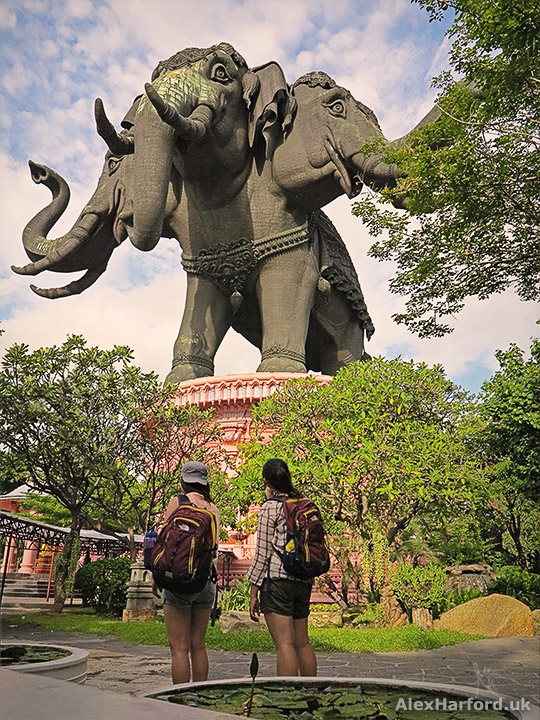
Airaavatha is the king of all elephants in Hindu tradition, and Erawan (ivory-white in colour in the mythology) is one of the Thai names for Airaavatha. Erawan is the size of a mountain and depicted with either 3 or 33 heads. Thankfully, Lek Viriyaphan, the millionaire businessman who dreamed up Erawan Temple, went with the former, as this three-headed elephant already weighs over 250 tons. The temple's museum claims it's the biggest hand-carved sculpture in the world.
Sadly, Lek Viriyaphan died (aged 85 or 86 in 2000) three years before the temple was finished. Alongside details of the construction, the temple doubles up as a museum with Asian art and ceramics from his private collection. Lek believed Thai culture had long been undermined at the expense of materialism, and his aim was preservation of Thai culture. That may seem hypocritical after making his riches importing luxury European cars, though the temple was constructed with many recycled materials, such as glass bottles for the ceiling.
Inside the Erawan Temple
Saying entering the temple was a Wow moment is an understatement. Winding stairs lead through three main floors showing the Hindu representation of the universe; Underworld (the underground museum), Earth (pictured below) and Heaven (inside the elephant). The sumptuous colours are like something out of the Guardians of the Galaxy films, with intricate carvings and porcelain mosaics depicting mythical creatures such as mermaids and dragons. Buddhist, Hindu and Christian scenes are included, with each religion having a dedicated pillar to hold up the elephant (Mahayana and Theravada Buddhism have a pillar each).
I wasn't expecting this, the incredible view on entering the temple...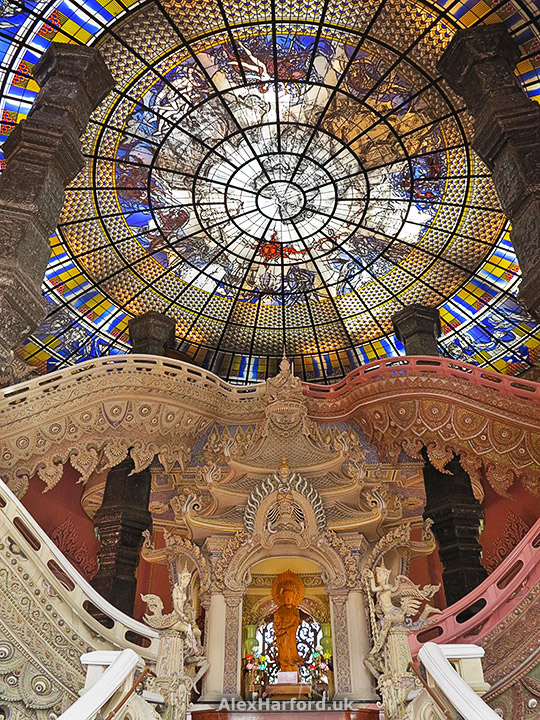 Beneath the stained-glass ceiling
Beneath the stained-glass ceiling An ornate, winding staircase rises to the temple's Heaven
An ornate, winding staircase rises to the temple's Heaven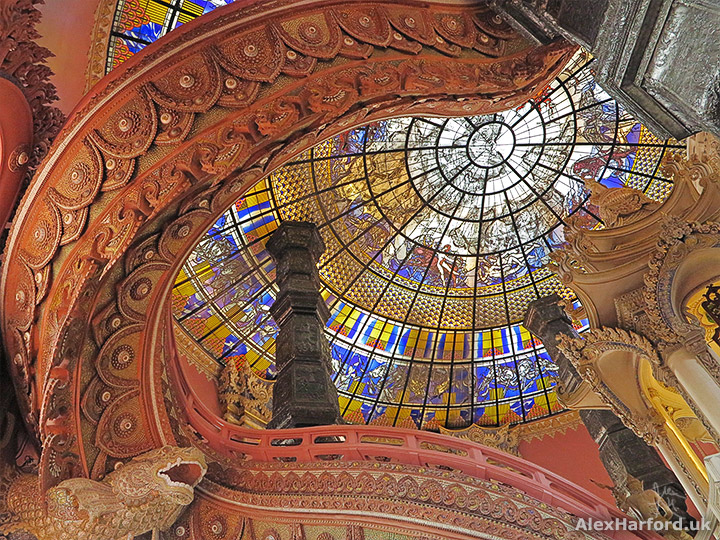 A close-up of the dragon-head mosaic
A close-up of the dragon-head mosaic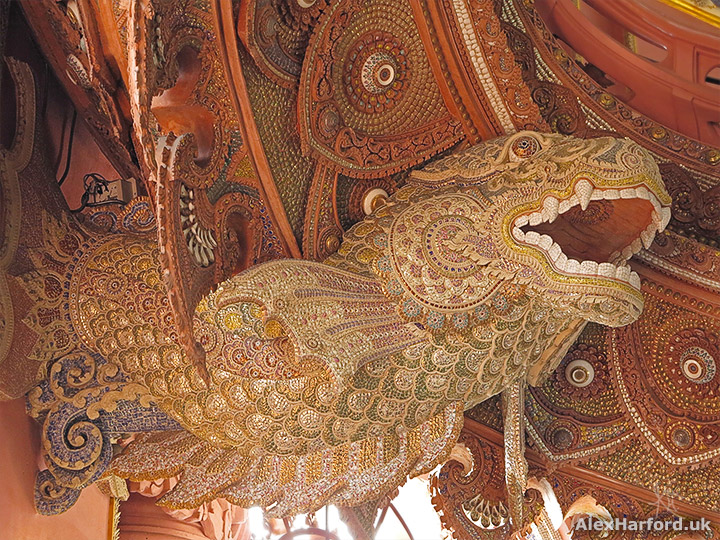 Ornate staircase and carving of a woman
Ornate staircase and carving of a woman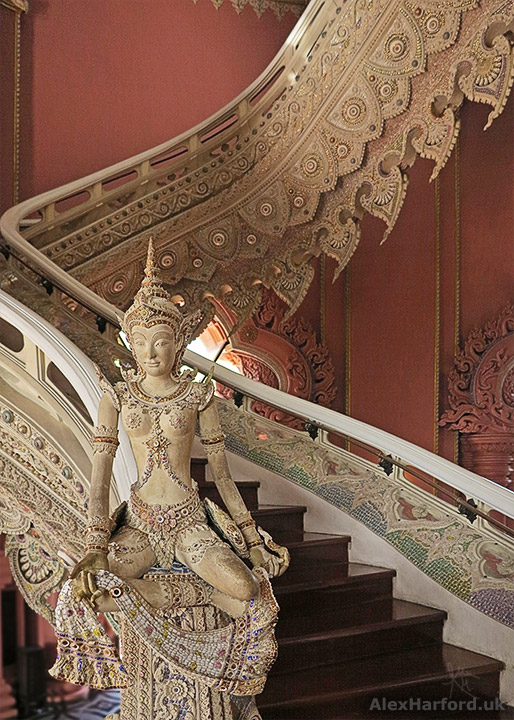 The temple is full of beautifully detailed sculptures
The temple is full of beautifully detailed sculptures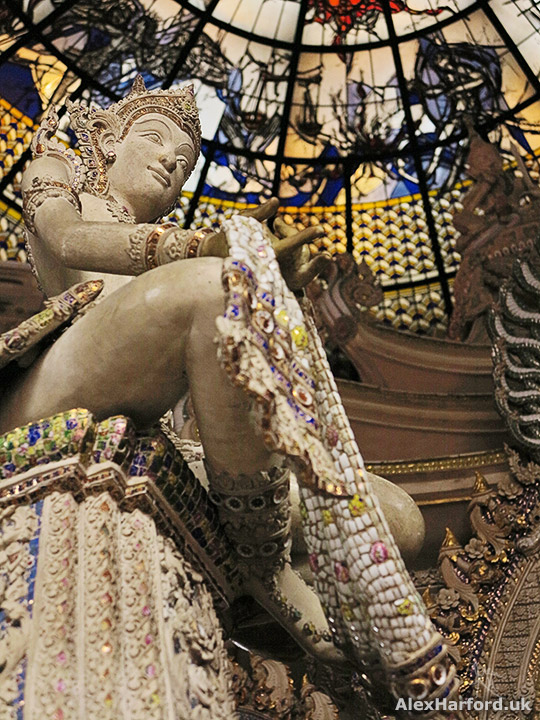 Naga are divine part-human, part-serpent creatures
Naga are divine part-human, part-serpent creatures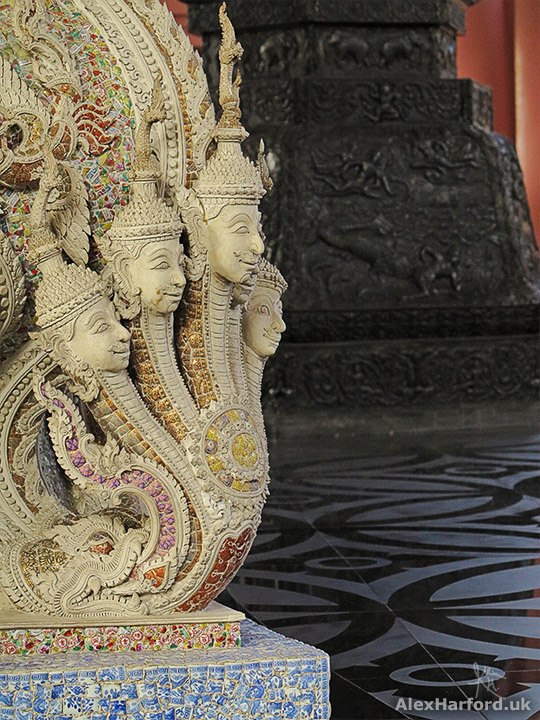 A few photos stitched together, showing the staircases leading to the top of the main room (Earth)
A few photos stitched together, showing the staircases leading to the top of the main room (Earth)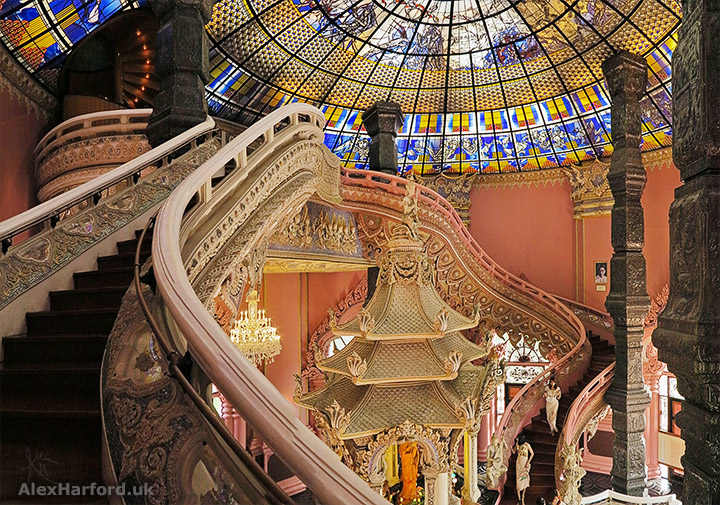 This time a vertical panorama to show more of the stained-glass ceiling
This time a vertical panorama to show more of the stained-glass ceiling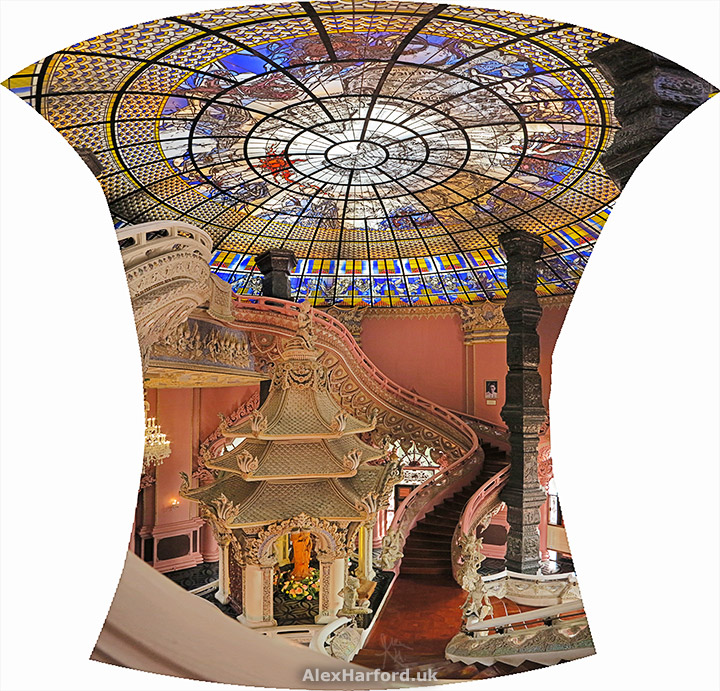
The glass ceiling was painted by German artist, Jacob Schwarzkopf, who sadly didn't live to see the finished building. He does have wall and glass paintings in over 300 buildings around the world, including his native Germany. Erawan's stained-glass ceiling is only comprised of the primary colours (which I didn't notice until I read it in the museum) and depicts a world map surrounded by the zodiac signs.
Jakob Schwarzkopf's stained-glass ceiling A lion-like head and feet backed by the stained-glass ceiling
A lion-like head and feet backed by the stained-glass ceiling View from the elephant's belly of a tusk pointing towards Bangkok
View from the elephant's belly of a tusk pointing towards Bangkok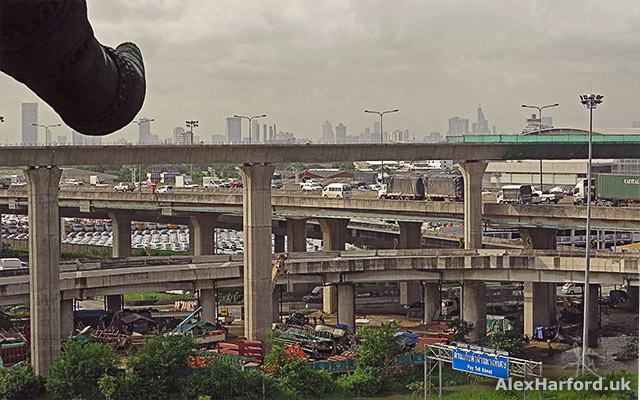 A flipped and mirrored image of ceiling details inside the elephant (Heaven)
A flipped and mirrored image of ceiling details inside the elephant (Heaven) The Buddhist temple inside the elephant, where it was very dark
The Buddhist temple inside the elephant, where it was very dark Back downstairs, musician sculptures line the walls
Back downstairs, musician sculptures line the walls
The Gardens
Erawan's gardens were a relaxing place to wander when I visited, with numerous sculptures of people and creatures from Thai mythology amongst rare trees from across Thailand.
I think this sculpture is a winged Thai qilin Naga, the serpent-like mythological Thai creatures
Naga, the serpent-like mythological Thai creatures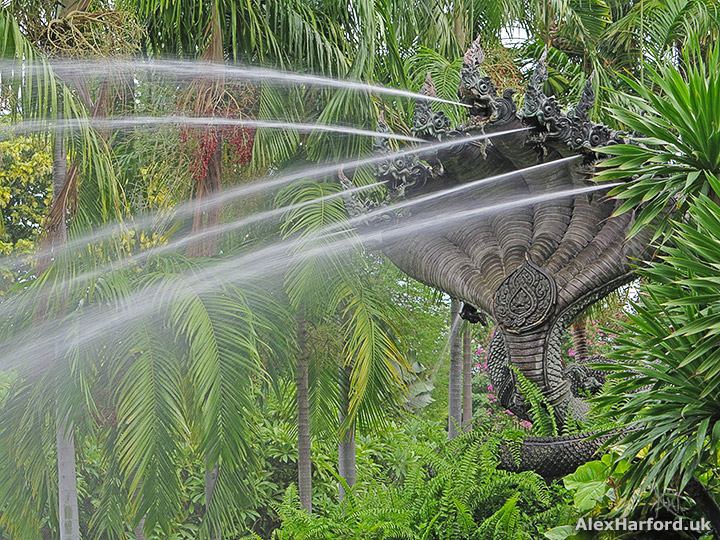 Guy chilling out in the gardens
Guy chilling out in the gardens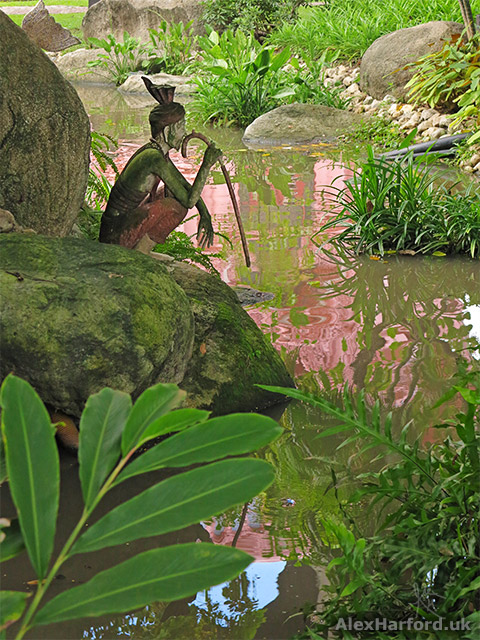 Another creature from Thai mythology - I'm not sure which? It doesn't look enough like anything I've seen pictured elsewhere
Another creature from Thai mythology - I'm not sure which? It doesn't look enough like anything I've seen pictured elsewhere Elephant fish play by the waterfall
Elephant fish play by the waterfall
Getting There
The temple is technically just outside Bangkok in Samut Prakan Province.
From Bangkok's centre, the Sukhumvit Line Skytrain, which was under construction when I visited, now stops near Erawan, with a great raised view as you pass by.
The view down Sukhumvit Road from Bang Na Station, where I walked the 3 miles to Erawan from. It was a very straight road, so impossible to get lost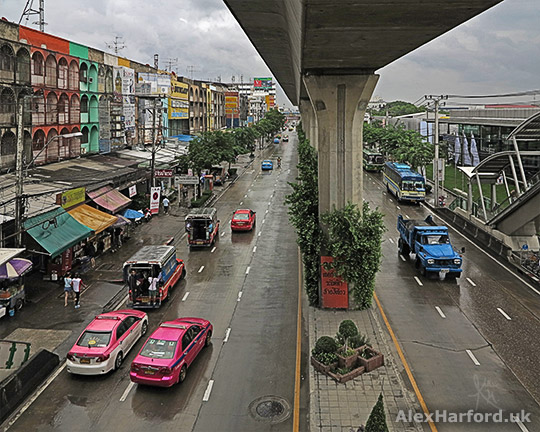 The now-finished extension to the Sukhumvit line was under construction when I visited Bangkok
The now-finished extension to the Sukhumvit line was under construction when I visited Bangkok
Official English-language website: erawanmuseum.com/en/.
The Erawan Temple was equally surreal and beautiful. Have you seen anywhere comparable?



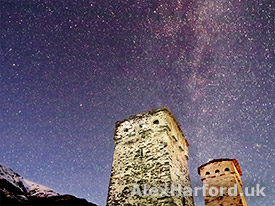
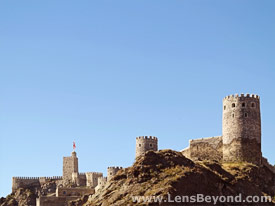



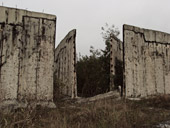
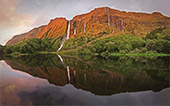


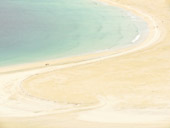
Comments